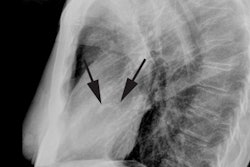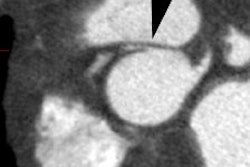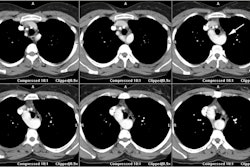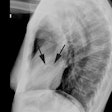Absence of the Pericardium:
Clinical:
Congenital absence of the pericardium is a rare, typically asymptomatic condition. It is due to failure of pericardial development secondary to premature atrophy of the left duct of Cuvier (cardinal vein) which fails to supply the left pleuropericardial membrane which forms the pericardium. The right duct of Cuvier normally persists as the superior vena cava, which assures adequate blood supply to the developing right pericardium - hence, left sided defects are more common (accounting 75-80% of cases; right sided defects account for 4-17% of cases [3]). Partial defects (large ones more commonly than small ones) are more frequent than total defects [2]. Patients are often asymptomatic, but symptoms can occur when cardiac structures are transiently entrapped or incarcerated in the defect [2]. Herniation of the left atrial appendage through a small defect may lead to infarction of the appendage, or the left coronary artery may be compressed, leading to ischemia, especially during exercise [2]. In about one-third to half of patients, pericardial defects are associated with other congenital anaomalies such as bronchogenic cysts, VSD's, PDA's, or diaphragmatic hernia [2,3]. Treatment of pericardial absence is usually observation - especially for large partial defects or complete absence [3]. Surgical pericardioplasty is usually reserved for symptomatic patients or partial defects [3].Types of defects include:
1- Complete left side absence (35%): Complete left sided absence is
3 times more common than partial left-sided absence [3]. With complete
left sided
absence
there can be cardiac rotation causing EKG changes (right axis
deviation).
Patients with complete absence of the left pericardium are typically
asymptomatic [3]. Chest pain, possibly due to torsion of the great
vessels or
pleuropericardial
adhesions due to inflammatory episodes, has been described in up to 33%
of patients.[1] Distortion of the ventricular geometry will elongate
the chordae of the anterior leaflet of the tricuspid valve,
contributing to regurge, which is a common finding in large partial or
total left-sided absence [3]. ECG findings usually show right-axis
deviation, right bundle branch block, and poor R-wave progression [3].
2- Partial Left/Diaphragmatic pericardial aplasia (15%)
3- Partial Foraminal Left: (35%): These patients are at risk for left atrial appendage herniation/strangulation and the lesions is usually repaired surgically due to this risk. Partial absence can cause no symptoms or can result in chest pain, dyspnea, and syncope related to herniation and strangulation of the cardiac structures through the defect [3].
4- Bilateral total absence/total absence of the pericardium (9-10% of cases [3]: Total absence of the pericardium is thought to occur secondary to premature atrophy of both cardial veins [3]. The condition can be associated with severe congenital anomalies such as incomplete closure of the chest wall, ectopia cordia, and omphalocele [3]. Cardiac herniation and strangulation do not occur, however, increased tension or strain because of cardiac hypermobility may be a cause of pain [3].
5- Foraminal right (4%): Other congenital anomalies are found in 30%
of these patients- most commonly bronchogenic cysts (30%), but other
anomalies
such as sequestrations, congenital heart disease (VSD, PDA, mitral
stenosis),
and diaphragmatic hernia may be found.
6- Complete right sided absence
X-ray:
Complete left sided absence of the pericardium demonstrates leftward displacement of the heart (with the trachea remaining in the midline), a slight RAO configuration to the heart with lack of visualization of the right heart border due to superimposition of the spine, a prominent pulmonary artery segment, and lucency caused by interposition of the lung between the inferior cardiac border and the diaphragm, and between the aorta and main pulmonary artery segment. If there is associated absence of the sternopericardial ligament, the heart will fall away from the anterior chest wall more than usual on the lateral exam. A classic finding is pneumopericardium associated with a left sided pneumothorax. CXR findings associated with partial left sided absence (foraminal) include an abnormal cardiac contour with prominence in the region of the left atrial appendage/main pulmonary artery and no evidence of tracheal deviation.The problem with CT and MR imaging of left sided pericardial defects is the inability of these modalities to visualize the pericardium in this part of the heart [2]. Cardiac MRI may miss absnece in up to 10% of patients becuase of decreased spatial resolution compared to CT [3]. Lung within the preaortic recess, interposed between the aorta and pulmonary artery anteriorly, is a characteristic finding [3].
In partial absence, an indirect sign of a defect is a cardiac indentation at the location of the defect [2] or a focal buldge [3]. Positional changes to the left lateral decubitus position can be helpful in diagnosing the defect as the herniaiton is often intermiittent [2].
REFERENCES:
(1) Radiology 1980; Baim RS et al. Computed tomography of absent
left
pericardium. April: 127-128.
(2) Radiology 2013; Bogaert J, Francone M. Pericardial disease:
value of CT and MR imaging.
267: 340-356
(3) J Cardiovasc Comput Tomogr 2013; Verde F, et al. Congenital
absence of the pericardium and its mimics. 7: 11-17






